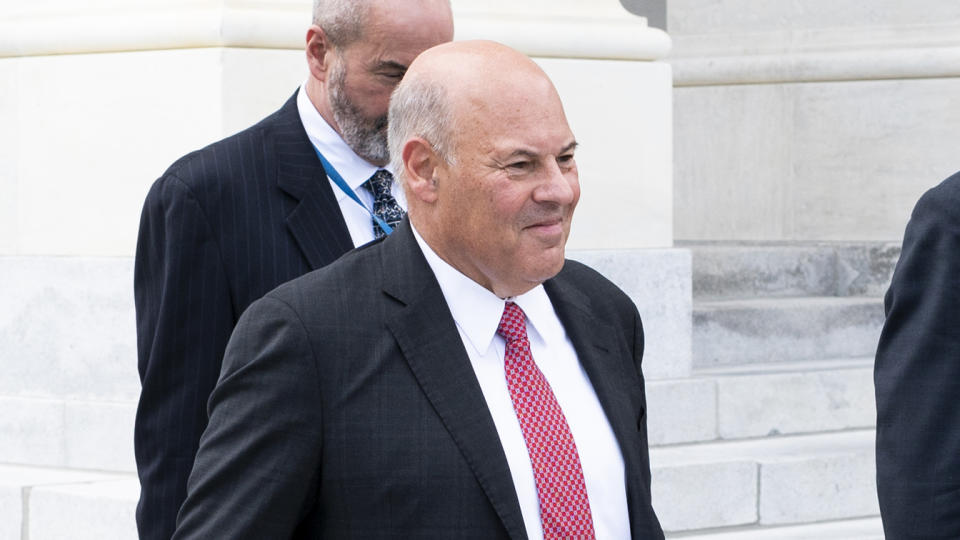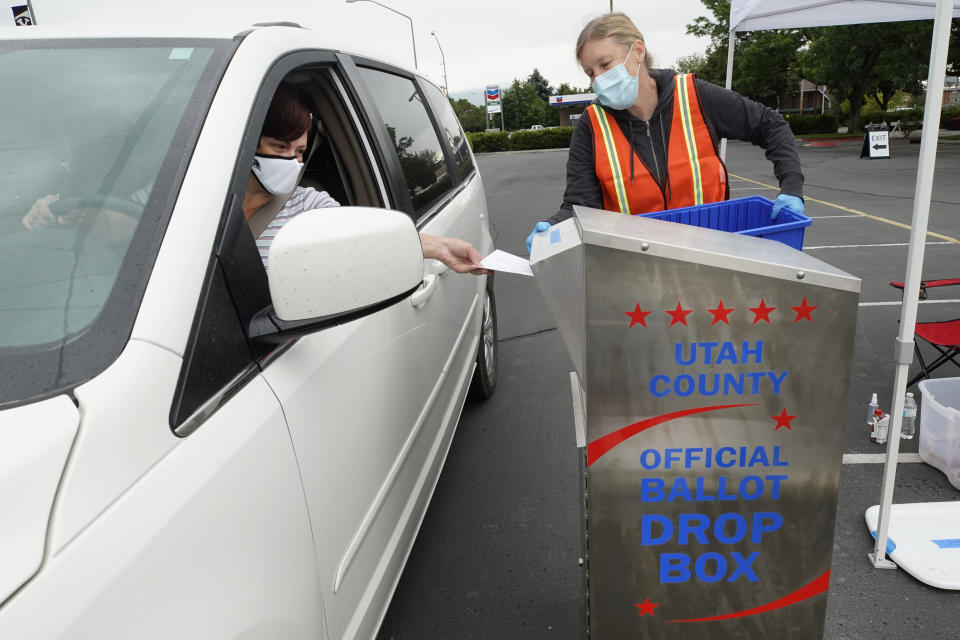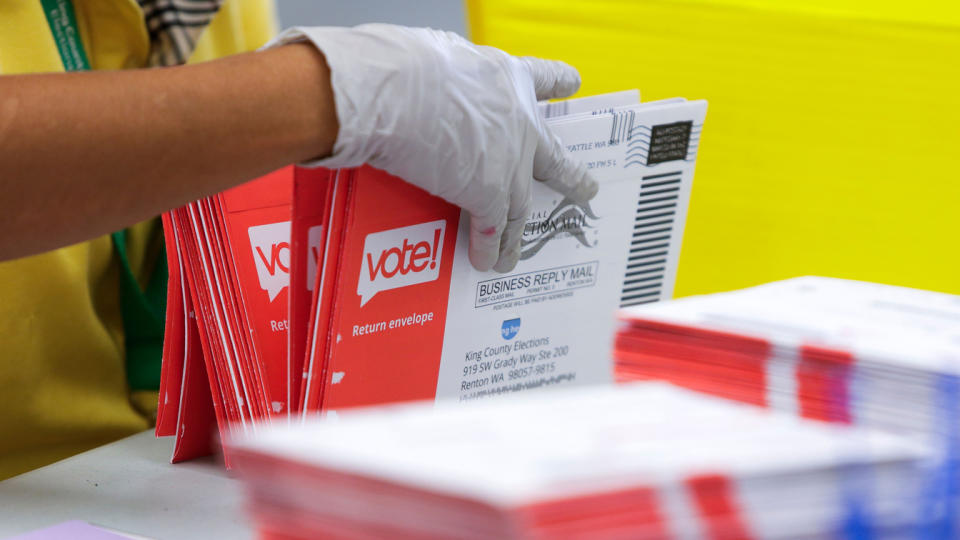You don't need the U.S. Postal Service to deliver your mail-in ballot
Many American voters are caught between competing concerns regarding the fall presidential election, as they weigh fears about the public health risks of voting in person against growing alarm about the ability of the U.S. Postal Service to deliver a mail-in ballot on time.
Worries about the Postal Service have mounted in recent days after President Trump said he might oppose funding the agency to stop Americans from voting by mail. And on Friday it was revealed that the Postal Service recently warned 46 states and the District of Columbia that it may not be able to deliver all mail-in ballots on time.
That comes after a few weeks of reports about the recently installed Postmaster General Louis DeJoy — a wealthy Trump donor with potential financial conflicts of interest in the mail industry — making changes to the Postal Service that are already causing a slowdown in mail delivery.

But there are ways to vote by mail without having to rely on the Postal Service to return your ballot. You could call it a hybrid process of receiving a ballot early through the mail and then returning it in person, before Election Day.
The Postal Service is the only way to receive an absentee or mail-in ballot in most states.
But voters do not have to use the Postal Service to send in their mail-in ballot. In other words, voters have a few options to return those ballots before Election Day without having to stand in line or worry about their vote being delivered too late to count.
One option available in most states is to fill out a mail-in ballot and deliver it to your local election office. Most states organize their local elections by county. But voters can go on their state Board of Elections or secretary of state website and look for a list of local election offices.
A second option is to take your mail-in ballot to an early voting site. There are only five states that as of now don’t have an in-person early voting period this fall, according to a database compiled by the Voting Rights Lab, a group dedicated to increasing voter participation. Those states are Kentucky, Michigan, Mississippi, Missouri and South Carolina.
But again, the specific days for early voting vary by state, so the best way to figure out when and where you can vote in person at an early voting site is to go to your state election website.
The added bonus of going to an in-person early voting site is that if you are not a registered voter yet — and you don’t have a ballot yet — in 21 states you can register the same day you vote.
A third option to bypass the U.S. Postal Service is to use a drop box. This is a secure receptacle in which you can deliver your completed mail-in ballot.

Drop boxes are a relatively recent development and were initiated by the states that started conducting their elections entirely by mail over the last 10 to 20 years.
Washington state has tracked drop box usage since the 2012 election. In that year, just over a third of all ballots returned came in through secure drop boxes. In 2016, drop boxes accounted for almost two-thirds of all returned ballots.
There are variations of secure drop boxes, with some available 24 hours a day and seven days a week, monitored by video surveillance. Others are available only during certain hours of the day and monitored by election workers. The U.S. Election Assistance Commission has guidance on drop boxes that recommends one box for every 15,000 to 20,000 registered voters, and to start publicizing the locations of these drop boxes about 80 days ahead of the election.
The presidential election on Nov. 3 is 80 days away as of today.
Some states are on schedule. Michigan, for example, a key swing state that could decide the presidential election, will have over 900 drop boxes available to voters and has a published list of the location of every drop box, which you can see by clicking here. Michigan is one of the five states that do not have in-person early voting, but by requesting a mail-in ballot and then returning it to a drop box, voters have access to a modified form of in-person early voting, starting 45 days before Election Day.
North Carolina, another swing state, does not have drop boxes. But a spokesman for the state Board of Elections, Patrick Gannon, said, “North Carolina law allows for absentee-by-mail ballots, if not mailed, to be dropped off at the county Board of Elections or at any One-Stop early voting site in the county.”
“Most counties have multiple early voting sites,” Gannon said.
Voters in some states can have another person deliver their mail-in ballot for them. But state laws vary on whether this is allowed and, if it is, it’s often restricted to close relatives or legal guardians. Nineteen states and the District of Columbia allow anyone to return ballots on behalf of voters, according to the Voting Rights Lab. Voters should consult their state election website for specifics on this particular question.

Marc Elias, a Democratic attorney who is overseeing much of the litigation to ensure more access to voting, wrote on his blog on Friday that “community organizations in states that allow ballot collection should consider setting up their own drop boxes now.”
“Local libraries, church groups and civic associations should explore setting up secure ballot drop boxes. There may even be a role for businesses to play in preserving our right to vote through drop box placement and security,” Elias wrote. “While we all prefer that states take on this important role, we cannot let democracy suffer at the hands of state inaction or presidential intimidation.”
Mike Ricci, a spokesman for Maryland Gov. Larry Hogan, said this state has 127 drop boxes but is working on getting more.
Arizona, which already conducts about 80 percent of its voting by mail, has drop boxes, but the secretary of state, Katie Hobbs, does not have a statewide list of locations, a spokeswoman said. Voters need to consult their county election office for drop box locations.
In some states, there is uncertainty about whether drop boxes will be provided in significant numbers. In Ohio, for example, Republican Secretary of State Frank LaRose said this week he would limit drop boxes to one per county. But LaRose spokesman Jon Keeling told Yahoo News he “is absolutely supportive of additional drop boxes, but we need legislation to get that done.”
In Pennsylvania, meanwhile, President Trump sued election officials in the state on June 29 to, in part, stop them from using drop boxes in the fall election. That litigation is still pending.
_____
Read more from Yahoo News:



